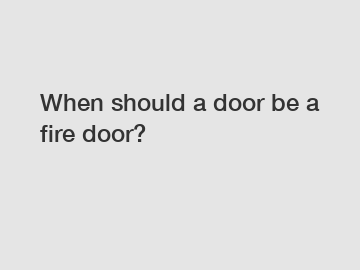When should a door be a fire door?
Every building, regardless of its purpose or size, needs to prioritize safety. One crucial aspect of building safety is having effective fire protection measures in place, and a key component of that is installing fire doors. These specialized doors play a critical role in preserving life and property during an emergency. In this blog post, we will explore why and when a door should be a fire door, ensuring a high level of safety is maintained.
Understanding Fire Doors:
Fire doors are purpose-built to withstand and impede the spread of fire, smoke, and toxic gases within a building. When a fire breaks out, these doors create a barrier, allowing occupants enough time to evacuate safely and minimizing property damage. They are typically made of fire-resistant materials and equipped with seals or intumescent strips that expand under high heat, forming an effective seal against smoke and fire.

When a Door Should be a Fire Door:
1. Building Regulations and Codes:
Fire safety regulations and building codes provide clear guidelines on where fire doors should be installed. These codes specify the locations, specifications, and acceptable fire rating of fire doors for various types of buildings. Compliance with these regulations is mandatory to ensure the safety of occupants and to meet legal requirements. When building or renovating, it is crucial to consult these regulations and engage professionals to ensure the correct installation and maintenance of fire doors.
2. Compartmentation:
Fire doors are crucial in achieving compartmentation within a building. Compartmentation refers to the division of a building into distinct compartments, each with its own fire-resistant boundaries. Fire doors are installed in these boundaries, preventing fire and smoke from spreading rapidly and keeping occupants safe. Compartmentation is essential in both residential and commercial buildings to contain potential fire hazards and allow for effective firefighting.
3. Escape Routes:
Fire doors are an essential part of creating safe escape routes within a building. During an emergency, occupants need clear pathways to evacuate quickly and safely. Fire doors are strategically placed along escape routes, such as corridors, stairwells, and exits, providing a vital shield against fire and smoke inhalation. They also serve to prevent the fire from blocking escape routes, ensuring a clear pathway for evacuation.
4. High-Risk Areas:
Certain areas within a building are more prone to fires, such as kitchens, utility rooms, boiler rooms, and storage spaces. These areas often house flammable materials or electrical equipment, increasing the risk of fire. Fire doors are essential in protecting these high-risk areas and preventing the spread of fire to other parts of the building. Installing fire doors in such areas creates an additional layer of protection for both occupants and property.
5. Shared Spaces:
Buildings with multiple occupancy, such as hospitals, hotels, offices, and residential complexes, require fire doors to separate different areas and protect individuals and property. Fire doors are installed to separate private living spaces from shared spaces like corridors, stairwells, and common rooms. This restricts the spread of fire and ensures safe movement within the building, facilitating a swift evacuation for everyone.
Conclusion:
In the pursuit of building safety, fire doors play an integral role in preventing the spread of fire, smoke, and toxic gases. A well-designed fire door system can significantly reduce the impact of a fire, saving lives and minimizing property damage. Adhering to building regulations and implementing fire doors in the required locations, such as compartmentation areas, escape routes, high-risk areas, and shared spaces, is crucial.
Remember, safety is a collective responsibility. Regular maintenance, proper installation, and periodic inspections of fire doors ensure their effectiveness during emergencies. By prioritizing fire safety through the installation of fire doors, we can protect occupants, preserve property, and provide peace of mind in the face of potential fire hazards.
For more etched stainless steel sheets grade 304, Etched Stainless Steel Sheet Manufacturer, Ti-Golden Hairline with PVD Colorinformation, please contact us. We will provide professional answers.

Comments